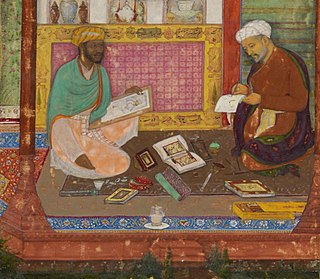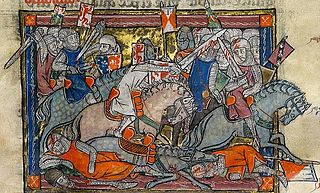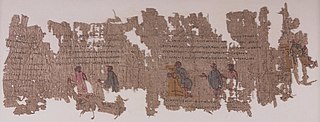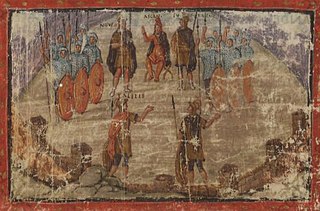 W
WAM 738 4to or Edda oblongata is an Icelandic paper manuscript dated to ca. 1680. It is housed in the Árni Magnússon Institute for Icelandic Studies, Reykjavík. It consists of 135 leaves and contains an illustrated copy of the Prose Edda, with 23 drawings of subjects from Norse mythology. The manuscript's name derives from its distinct oblong format; the book is unusually tall compared to its width.
 W
WThe Ambrosian Iliad or Ilias Picta is a 5th-century illuminated manuscript on vellum, which depicts the entirety of Homer's Iliad, including battle scenes and noble scenes. It is considered unique due to being the only set of ancient illustrations that depict scenes from the Iliad. The Ambrosian Iliad consists of 52 miniatures, each labeled numerically, created in Alexandria, given the flattened and angular Hellenistic figures, which is considered typical of Alexandrian art in the Late Antiquity period, in approximately 500 AD, possibly by multiple artists. The author(s) first drew the figures nude and then painted the clothes on, much like in Greek vase painting. In the 11th century, the miniatures were cut out of the original manuscript and pasted into a Siculo-Calabrian codex of Homeric texts.
 W
WThe Auchinleck Manuscript, NLS Adv. MS 19.2.1, currently forms part of the collection of the National Library of Scotland. It is an illuminated manuscript copied on parchment in the 14th century in London. The manuscript provides a glimpse of a time of political tension and social change in England. The English were continuing to reclaim their language and national identity, and to distance themselves from the Norman conquerors who had taken over the country after the Battle of Hastings 300 years before.
 W
WThe Book of the White Earl is an Irish religious and literary miscellany created c. 1404–1452.
 W
WThe Charioteer Papyrus is a 5th-century fragment of an illustration from an unknown work of literature. It is one of the finest surviving fragments of classical book illustration. Unlike other surviving illustrated fragments of papyrus, such as the Romance Papyrus and the Heracles Papyrus, which have illustrations that are little more than mere sketches, the Charioteer Papyrus is sensitively drawn and finely colored. It shows portions of six charioteers in red or green tunics. Although there is no text on the fragment, it undoubtedly served an illustration for a literary work, perhaps serving as an illustration for the chariot race at the games at the funeral of Patroclus in the Iliad.
 W
WCodex Frisianus or Fríssbók is a manuscript of the early fourteenth century.
 W
WThe Codex Manesse, Manesse Codex, or Große Heidelberger Liederhandschrift is a Liederhandschrift, the single most comprehensive source of Middle High German Minnesang poetry, written and illustrated between c. 1304 when the main part was completed, and c. 1340 with the addenda.
 W
WThe Cod. Pal. germ. 339 is an illustrated manuscript of Wolfram von Eschenbach's Parzival, created in Hagenau in the 1440s in the workshop of Diebold Lauber.
 W
WThe Cod. Pal. germ. 359 is an illustrated manuscript created in Strasbourg ca. 1418. It contains the texts Rosengarten zu Worms and Lucidarius.
 W
WMS NKS 1867 4° is a 1760 paper manuscript now in the Danish Royal Library, Copenhagen, containing skaldic poetry, assorted runological information, the prose Edda and the poetic Edda:Sólarljóð Samtak um rúnir, Björn Jónsson á Skarðsá
 W
WThe Ellesmere Chaucer, or Ellesmere Manuscript of the Canterbury Tales, is an early 15th-century illuminated manuscript of Geoffrey Chaucer's Canterbury Tales, owned by the Huntington Library, in San Marino, California. It is considered one of the most significant copies of the Tales.
 W
WFlateyjarbók is an important medieval Icelandic manuscript. It is also known as GkS 1005 fol. and by the Latin name Codex Flateyensis. It was commissioned by Jón Hákonarson and produced by the priests and scribes Jón Þórðarson and Magnús Þórhallsson.
 W
W"Hasht-Bihisht" is a famous poem written by Amir Khusrow around 1302 AD. The poem is based on the Haft Paykar by Nizami, written around 1197 AD, which in turn takes its outline from the earlier epic Shahnameh written by Firdausi around 1010 AD. Like Nizami's Haft Paykar, Khusro's Hasht Bihisht uses a legend about Bahram V Gur as its frame story and, in the style of One Thousand and One Nights, introduces folktales told by seven princesses. Most famously, Khusro appears to be the first writer to have added The Three Princes of Serendip as characters and the story of the alleged camel theft and recovery.
 W
WThe Heracles Papyrus is a fragment of a 3rd-century Greek manuscript of a poem about the Labors of Heracles. It contains three unframed colored line drawings of the first of the Labors, the killing of the Nemean Lion, set within the columns of cursive text. It was found at Oxyrhynchus and is one of the few surviving scraps of classical literary illustration on papyrus. The fragment is 235 by 106 mm.
 W
WSÁM 66 is an 18th-century manuscript now at the Árni Magnússon Institute for Icelandic Studies, Iceland. Reference information and a copy of this manuscript can be found online. This book was written in Iceland in 1765 and 1766. The back cover is dated 1765. The text follows that of earlier manuscripts and printed books. However the book contains a nice collection of illustrated pages on pages 73-80.
 W
WThe Junius manuscript is one of the four major codices of Old English literature. Written in the 10th century, it contains poetry dealing with Biblical subjects in Old English, the vernacular language of Anglo-Saxon England. Modern editors have determined that the manuscript is made of four poems, to which they have given the titles Genesis, Exodus, Daniel, and Christ and Satan. The identity of their author is unknown. For a long time, scholars believed them to be the work of Cædmon, accordingly calling the book the Cædmon manuscript. This theory has been discarded due to the significant differences between the poems.
 W
WThe illuminated manuscript Khamsa of Nizami British Library, Or. 12208 is a lavishly illustrated manuscript of the Khamsa or "five poems" of Nizami Ganjavi, a 12th-century Persian poet, which was created for the Mughal Emperor Akbar in the early 1590s by a number of artists and a single scribe working at the Mughal court, very probably in Akbar's new capital of Lahore in North India, now in Pakistan. Apart from the fine calligraphy of the Persian text, the manuscript is celebrated for over forty Mughal miniatures of the highest quality throughout the text; five of these are detached from the main manuscript and are in the Walters Art Museum, Baltimore as Walters Art Museum MS W.613. The manuscript has been described as "one of the finest examples of the Indo-Muslim arts of the book", and "one of the most perfect of the de luxe type of manuscripts made for Akbar".
 W
WLebor na hUidre [ˈl͈ʲevor nˠə huiðʲrʲə] or the Book of the Dun Cow is an Irish vellum manuscript dating to the 12th century. It is the oldest extant manuscript in Irish. It is held in the Royal Irish Academy and is badly damaged: only 67 leaves remain and many of the texts are incomplete. It is named after an anachronistic legend that it was made from the hide of a dun cow by Saint Ciarán of Clonmacnoise.
 W
WThe Red Book: Liber Novus is a red leather‐bound folio manuscript crafted by the Swiss psychiatrist Carl Gustav Jung between 1915 and about 1930. It recounts and comments upon the author's psychological experiments between 1913 and 1916, and is based on manuscripts (journals), known as Black Books, first drafted by Jung in 1913–15 and 1917. Despite being nominated as the central work in Jung's oeuvre, it was not published or made otherwise accessible for study until 2009.
 W
WThe Rochefoucauld Grail is a four-volume 14th-century illuminated manuscript. Three volumes were formerly Amsterdam, Bibliotheca Philosophica Hermetica, MS 1; the fourth volume is divided between the Bodleian Library in Oxford and the John Rylands Library in Manchester. It contains the Lancelot-Grail cycle in French prose, the oldest and most comprehensive surviving version of the legend of King Arthur and the Holy Grail. The leaves are about 405 mm by 295 mm, and are written in two columns, by a number of scribes.
 W
WThe Romance Papyrus is a fragment of 2nd century Greek manuscript of an unknown romance. It contains three unframed illustrations set within the columns of text. It is one of the few surviving scraps of classical literary illustration on papyrus. The fragment is 340 by 115 mm. It was acquired by the Bibliothèque Nationale in 1900.
 W
WThe Vergilius Augusteus is a manuscript from late antiquity, containing the works of the Roman author Virgil, written probably around the 4th century. There are two other collections of Virgil manuscripts, the Vergilius Vaticanus and the Vergilius Romanus. They are early examples of illuminated manuscripts; the Augusteus is not illuminated but has decorated initial letters at the top of each page. These letters do not mark divisions of the text, but rather are used at the beginning of whatever line happened to fall at the top of the page. These decorated initials are the earliest surviving such initials.
 W
WThe Vergilius Romanus, also known as the Roman Vergil, is a 5th-century illustrated manuscript of the works of Virgil. It contains the Aeneid, the Georgics, and some of the Eclogues. It is one of the oldest and most important Vergilian manuscripts. It is 332 by 323 mm with 309 vellum folios. It was written in rustic capitals with 18 lines per page.
 W
WThe Vergilius Vaticanus, also known as Vatican Virgil, is a Late Antique illuminated manuscript containing fragments of Virgil's Aeneid and Georgics. It was made in Rome in around 400 C.E., and is one of the oldest surviving sources for the text of the Aeneid. It is the oldest and one of only three ancient illustrated manuscripts of classical literature.
 W
WThe Weingarten Manuscript is a 14th-century illuminated manuscript containing a collection of Minnesang lyrics. It is currently in the Württembergische Landesbibliothek, Stuttgart, with the shelf-mark HB XIII 1. In Minnesang scholarship it is referred to as Manuscript B.